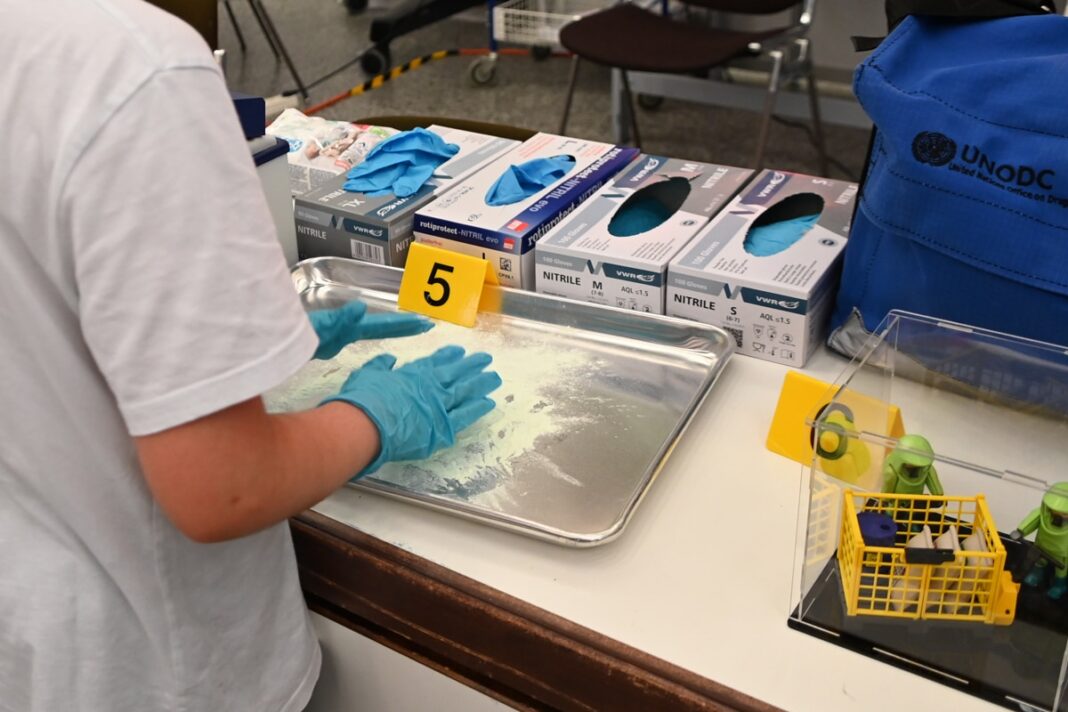ទីក្រុងវីយែន (អូទ្រីស) ថ្ងៃទី ១៦ ខែ ឧសភា ឆ្នាំ ២០២២ – How can science and research support peace and development around the world? How can data and information help us prevent crime?
These are among the questions that the Vienna International Center’s exhibition sought to answer for the more than 1,400 visitors attending the 2022 Long Night of Research, an Austria-wide event showcasing 2,500 science and research stations across the country.
ដឹកនាំដោយ ទីភ្នាក់ងារថាមពលបរមាណូអន្តរជាតិ។ (IAEA) with contributions from UN agencies present in Vienna, the Long Night of Research, held on 20 May 2022, demonstrated how the UN is contributing its scientific data and innovation to create a safer and more peaceful world. The ការិយាល័យអង្គការសហប្រជាជាតិទទួលបន្ទុកគ្រឿងញៀន និងឧក្រិដ្ឋកម្ម (UNODC) contributed two exhibitions to the night.
How can we protect those who protect us?
The first exhibition described a variety of threats that forensic officers face when carrying out their duties – including encountering unknown substances and chemicals. Experts from the UNODC Laboratory and Scientific Service demonstrated how officers deal with chemical seizures in a remote environment. Visitors further learned which Personal Protective Equipment (PPE) was required to keep our officers safe when handling or disposing of chemicals.
For example, at the booth, UNODC staff showed how to properly use PPE by having visitors wear gloves, touch a special substance, remove the gloves, and then examine their hands under a special machine. If the gloves were not removed properly, traces of the substance would glow under the machine’s special light.
UNODC staff also បង្ហាញ how to get fingerprinted and the use of modern handheld devices to help with identifying unknown substances, something which Alexander Loren, ten, found exciting: “If you don’t know what drug it is, the machine can identify it! I identified paracetamol for headaches. It was fun.”
Can data help us prevent crime?
Through its huge data collection on various types of crime, UNODC helps police, detectives, policymakers and others to reduce crime around the world. The second exhibition allowed visitors to spot illicit crops on satellite images to fight the world drug problem, watch videos explaining how drugs are produced from opium poppy and coca bush, and learn how alternative development can provide farmers in vulnerable communities with incentives for alternative livelihoods.
A display of chocolate, teas, soaps, coffee, and more adorned the booth as real-life examples of how UNODC works to help farmers find ជម្មើសជំនួស to planting coca bush, opium poppy, or cannabis. Visitors of all ages were also invited to participate in an interactive crime quiz based on latest findings from UNODC flagship publications, such as the ការសិក្សាសកលស្តីពីការធ្វើអត្តឃាត និង Global Report on Trafficking in Persons.
Another section of the booth asked children to match photos of trafficked products with the protected animals or plants – like tigers, pangolins, songbirds, elephants, etc. – affected by such trafficking. All the animals on display were protected under the Convention on International Trade in Endangered Species of Wild Fauna and Flora (CITES).
“I learned about different animals and plants and how they’re used,” explained Mia Chaari, an elementary school-aged girl. “For example, tigers, which were my favorite, are used for tiger bone wine.”
A third section of the booth featured a mannequin, decked out in several flashy clothing items. Visitors were asked to notice how the different items she was wearing were connected to crime. For example, she sported a counterfeit watch and sunglasses, shoes with leather made from a trafficked animal, and a phone that could eventually be considered electronic waste (e-waste).
To learn more about the different stations at the Vienna International Centre’s Long Night of Research, សូមចុចទីនេះ.
ពត៌មានបន្ថែម
UNODC research constitutes the key global authority in the fields of drugs and crime, providing high-quality, essential evidence to inform policy-making and valuable sources of knowledge in drugs and crime domains, including in the framework of the Sustainable Development Agenda. For more, សូមចុចទីនេះ.









